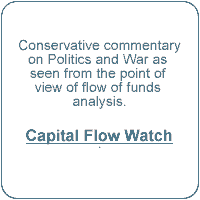 Mário Henrique Simonsen, Media S-N, Rio Stock Exchange
Mário Henrique Simonsen, Media S-N, Rio Stock Exchange
Historical Notes (continued)
Mario Henrique Simonsen, Media S-N, Rio de Janeiro Stock Exchange
Mário Henrique Simonsen : (1935-1997) Brazilian economist of the Fundação Getúlio Vargas and one of the three finance ministers responsible for the 'Economic Miracle'. An officer in the naval reserve, Mário Henrique Simonsen was trained as a civil engineer and started as a professor of advanced mathematics. He was regarded as a brilliant thinker throughout his career. As a professor at the Fundação Getulio Vargas in Rio de Janeiro for many years he was associated with Eugênio Gudin and Octávio Gouvêa de Bulhões. As a self-taught economist, Mário Henrique Simonsen was eclectic and non-doctrinaire. 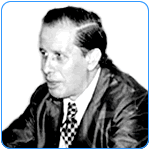 Mario Henrique Simonsen Mario Henrique SimonsenHe worked on reforms in housing finance under President Castelo Branco and was in charge of the Brazilian Movement for Alphabetization (MOBRAL) under President Emílio Garrastazu Médici. He was Minister of Finance under President Ernesto Geisel and was involved in the reform of Corporate Law and the establishment of the Securities Regulatory Commission. As a partner of Julio Bozano, of Banco Bozano Simonsen, he was the only finance minister of those who ran the 'Economic Miracle' who had private sector experience in the capital market. |
Média S-N : The first stock market average in Brazil that was adjusted for stock splits, designed by John Oswin Schroy in December 1959, and published daily in the newspaper Corrêio da Manhã since January 1960. The index was owned by John Schroy's firm, Serviço National de Investimentos Ltda. (hence the initials "S-N"). The Média S-N, throughout the 1960s was published in the Conjunctura Econômica and in the leading newspapers and in the financial statistics of the Banco do Brasil S.A. The original Média S-N had ten stocks and was back-calculated month by month to January 1954. The initial ten stocks were: Banco do Brasil, Cia. Docas de Santos, Cia. de Cigarros Souza Cruz, Cia Siderúrgica Belga Mineira, Refinaria e Exploração de Petrôleo União, Cia. Cervejaria Brahma, Cia. Nacional de Tecidos Nova America, Mesbla S.A., and Cia. Paulista de Força e Luz. 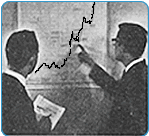 John Schroy and his partner, Geoffrey Langlands, examining the Média S-N. about 1962 John Schroy and his partner, Geoffrey Langlands, examining the Média S-N. about 1962Prior to the Média S-N, the Índice Brasil was published in São Paulo, but this equity index was not adjusted for stock splits. Since the custom in Brazil at the time was for companies to distributed free shares in ratios of 1 to 4 or higher each year, failure to adjust the stock average for free shares substantially understated the return on investment and helped perpetuate the common belief that Brazilian stocks were not a good investment. During the decade of the 1960s, the Média S-N was announced at 7 PM daily on the Vôz do Brasil, the official radio station, to the familiar evening opening strains of "O Guarani". In the 1970s, after ownership of the Média S-N passed to other hands, this popular index was discontinued and replaced by indices published by the stock exchanges. |
Modernization of the Rio de Janeiro Stock Exchange : During the decade of the 1960s, the Rio de Janeiro Stock Exchange was transformed from a sleepy financial backwater to the largest exchange in Latin America. Prior to the Revolution of 1964, intermediation in the securities market was the privilege of 40 official brokers, with life tenure, and with the right to pass their economic privileges to their heirs or favorites. 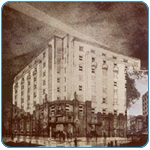 A privileged monopoly of official brokers blocked progress until the reforms of 1964 A privileged monopoly of official brokers blocked progress until the reforms of 1964As individuals, official brokers had no capital requirements and most operated from small offices in the Rio Stock Exchange building on Praça XV. By law, all transfers of corporate stock, even those that were privately negotiated, took place on the stock exchange with a commission paid to official brokers on both sides of the trade. There were no listed securities on the exchange, since trades in all stocks had to be 'registered' in the official 'auction'. Because even privately negotiated transactions of closed corporations had to be 'registered' on the exchange, the 'auction' was pretty much of a joke. There were no round lots for trading. There was no 'ticker'. Even though the volume was miniscule, the results of trading were known only hours later when the small exchange staff issued a one page mimeographed sheet, summarizing transactions. The daily auction was held around a 'corbeille' across which brokers shouted offers. The auction room was four stories high, decorated in marble, and graced with magnificent stained glass windows depicting symbols of commerce appropriate to the 1930s. The shouts of the brokers caused an impressive racket. 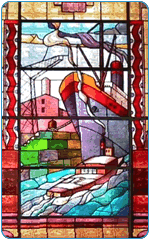 Symbols of commerce decorated the old Rio Bourse Symbols of commerce decorated the old Rio BourseSince most trades had been agreed prior to the 'auction', this ceremony was largely a sham, intended to preserve the official monopoly. The trading session lasted for fifteen or twenty minutes. Some brokers boasted of never having attended the 'leilão'. In the 1950s, the public could walk in off the street and stroll around the trading floor during an auction. Often, people would be seen dozing on the benches that lined the walls of the marble auction room. During the early 1960s, volume of the Rio Exchange began to pick up. There were various forces that drove prices, including:
Some official brokers maintained larger offices away from the Exchange building and actively solicited clients, including Luiz Cabral de Menezes, Célio Pelajo, M. Marcelo Leite Barbosa, and Ney Souza Ribeiro de Carvalho. The economic reforms of 1964 and 1965 brought many new brokers into the market. The new rules required that brokers be incorporated and have a minimum capital of about US$300,000 (dollar equivalent). In the same period, the introduction of indexed Treasury bonds and indexed real estate bonds, tax incentive 157 funds, and open-end mutual funds run by broker-dealers and investment banks, greatly increased the business opportunities in the brokerage business. To improve the trading system, Minister of Finance Octávio Gouvêia de Bulhões recommended that the Rio de Janeiro Stock Exchange contract John Schroy to prepare a modernization plan. |

